The Emperor's New Mind by Penrose Roger

Author:Penrose, Roger
Language: eng
Format: epub
Publisher: OUP Oxford
Published: 1989-02-26T16:00:00+00:00
Fig. 6.8. A probability amplitude represented as a point z within the unit circle in the Argand plane. The squared distance |z|2 from the centre can become an actual probability when effects become magnified to the classical level.
Note that for this to be an actual ‘normalized’ probability, the value of |z|2 must lie somewhere between 0 and 1. This means that for a properly normalized amplitude, the point z in the Argand plane must then lie somewhere in the unit circle (see Fig. 6.8). Sometimes, however, we shall want to consider combinations
w × alternative A + z × alternative B,
where w and z are merely proportional to the probability amplitudes, and then they need not lie in this circle. The condition that they be normalized (and therefore provide actual probability amplitudes) is that their squared moduli should sum to unity:
|w |2 + |z |2 = 1.
If they are not so normalized, then the actual amplitudes for A and B, respectively, are w/√(|w|2 + |z |2) and z/√(|w |2 + |z |2), which do lie in the unit circle.
We now see that a probability amplitude is not really like a probability after all, but rather more like a ‘complex square root’ of a probability. How does this affect things when effects at the quantum level get magnified so as to reach the classical level? Recall that in manipulating probabilities and amplitudes we sometimes needed to multiply them and we sometimes needed to add them. The first point to note is that the operation of multiplication poses no problem in our passing from the quantum to the classical rules. This is because of the remarkable mathematical fact that the squared modulus of the product of two complex numbers is equal to the product of their individual squared moduli:
|zw|2 = |z|2 |w|2.
(This property follows at once from the geometrical description of the product of a pair of complex numbers, as given in Chapter 3; but in terms of real and imaginary parts z = x + iy, w = u + iv, it is a pretty little miracle. Try it!)
This fact has the implication that if there is only a single route open to a particle, e.g. when there is only a single slit (say t) open, in the two-slit experiment, then one can argue ‘classically’ and the probabilities come out the same whether or not an additional detection of the particle is made at the intermediate point (at t).* We can take the squared moduli at both stages or only at the end, e.g.
|A(s, t)|2 × |A(t, p)|2 = |A(s, t) × A(t, p)|2,
and the answer comes out the same each way for the resulting probability.
However, if there is more than one route available (e.g. if both slits are open), then we need to form a sum, and it is here that the characteristic features of quantum mechanics begin to emerge. When we form the squared modulus of the sum, w + z, of two complex numbers w and z, we do
Download
This site does not store any files on its server. We only index and link to content provided by other sites. Please contact the content providers to delete copyright contents if any and email us, we'll remove relevant links or contents immediately.
| Computer Vision & Pattern Recognition | Expert Systems |
| Intelligence & Semantics | Machine Theory |
| Natural Language Processing | Neural Networks |
Algorithms of the Intelligent Web by Haralambos Marmanis;Dmitry Babenko(16280)
Jquery UI in Action : Master the concepts Of Jquery UI: A Step By Step Approach by ANMOL GOYAL(9408)
Test-Driven Development with Java by Alan Mellor(7737)
Data Augmentation with Python by Duc Haba(7612)
Principles of Data Fabric by Sonia Mezzetta(7383)
Learn Blender Simulations the Right Way by Stephen Pearson(7296)
Microservices with Spring Boot 3 and Spring Cloud by Magnus Larsson(7142)
Hadoop in Practice by Alex Holmes(6589)
RPA Solution Architect's Handbook by Sachin Sahgal(6519)
The Infinite Retina by Robert Scoble Irena Cronin(6220)
Big Data Analysis with Python by Ivan Marin(5937)
Life 3.0: Being Human in the Age of Artificial Intelligence by Tegmark Max(5520)
Pretrain Vision and Large Language Models in Python by Emily Webber(4897)
Infrastructure as Code for Beginners by Russ McKendrick(4658)
Functional Programming in JavaScript by Mantyla Dan(4441)
WordPress Plugin Development Cookbook by Yannick Lefebvre(4388)
The Age of Surveillance Capitalism by Shoshana Zuboff(4253)
Embracing Microservices Design by Ovais Mehboob Ahmed Khan Nabil Siddiqui and Timothy Oleson(4149)
Applied Machine Learning for Healthcare and Life Sciences Using AWS by Ujjwal Ratan(4137)
